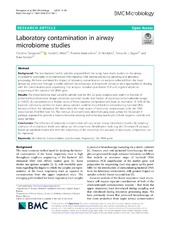| dc.contributor.author | Drengenes, Christine | en_US |
| dc.contributor.author | Wiker, Harald G | en_US |
| dc.contributor.author | Kalananthan, Tharmini | en_US |
| dc.contributor.author | Nordeide, Eli | en_US |
| dc.contributor.author | Eagan, Tomas Mikal | en_US |
| dc.contributor.author | Nielsen, Rune | en_US |
| dc.date.accessioned | 2020-04-26T19:32:05Z | |
| dc.date.available | 2020-04-26T19:32:05Z | |
| dc.date.issued | 2019-08-14 | |
| dc.Published | Drengenes C, Wiker HG, Kalananthan T, Nordeide E, Eagan TML, Nielsen R. Laboratory contamination in airway microbiome studies. BMC Microbiology. 2019;19:187 | eng |
| dc.identifier.issn | 1471-2180 | |
| dc.identifier.uri | https://hdl.handle.net/1956/22008 | |
| dc.description.abstract | Background The low bacterial load in samples acquired from the lungs, have made studies on the airway microbiome vulnerable to contamination from bacterial DNA introduced during sampling and laboratory processing. We have examined the impact of laboratory contamination on samples collected from the lower airways by protected (through a sterile catheter) bronchoscopy and explored various in silico approaches to dealing with the contamination post-sequencing. Our analyses included quantitative PCR and targeted amplicon sequencing of the bacterial 16S rRNA gene. Results The mean bacterial load varied by sample type for the 23 study subjects (oral wash>1st fraction of protected bronchoalveolar lavage>protected specimen brush>2nd fraction of protected bronchoalveolar lavage; p < 0.001). By comparison to a dilution series of know bacterial composition and load, an estimated 10–50% of the bacterial community profiles for lower airway samples could be traced back to contaminating bacterial DNA introduced from the laboratory. We determined the main source of laboratory contaminants to be the DNA extraction kit (FastDNA Spin Kit). The removal of contaminants identified using tools within the Decontam R package appeared to provide a balance between keeping and removing taxa found in both negative controls and study samples. Conclusions The influence of laboratory contamination will vary across airway microbiome studies. By reporting estimates of contaminant levels and taking use of contaminant identification tools (e.g. the Decontam R package) based on statistical models that limit the subjectivity of the researcher, the accuracy of inter-study comparisons can be improved. | en_US |
| dc.language.iso | eng | eng |
| dc.publisher | Springer Nature | eng |
| dc.rights | Attribution CC BY | eng |
| dc.rights.uri | https://creativecommons.org/licenses/by/4.0 | eng |
| dc.title | Laboratory contamination in airway microbiome studies | en_US |
| dc.type | Peer reviewed | |
| dc.type | Journal article | |
| dc.date.updated | 2020-02-04T13:03:12Z | |
| dc.description.version | publishedVersion | en_US |
| dc.rights.holder | Copyright the authors | |
| dc.identifier.doi | https://doi.org/10.1186/s12866-019-1560-1 | |
| dc.identifier.cristin | 1741726 | |
| dc.source.journal | BMC Microbiology | |
| bibo.doi | | |

